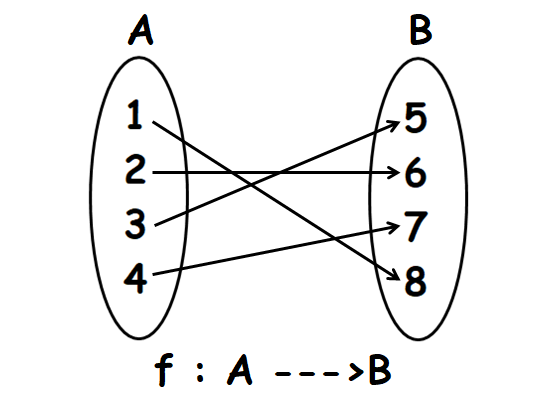BIJECTIVE FUNCTION
Let f : A ----> B be a function.
The function f is called as one to one and onto or a bijective function, if f is both a one to one and an onto function
More clearly,
f maps distinct elements of A into distinct images in B and every element in B is an image of some element in A.
The figure shown below represents a one to one and onto or bijective function.

Solved Problems
Problem 1 :
Let f : A ----> B. A, B and f are defined as
A = {1, 2, 3, 4}
B = {5, 6, 7, 8}
f = {(1, 8), (2, 6), (3, 5), (4, 7)}
Verify whether f is a function. if so, what type of function is f ?
Solution :
Write the elements of f (ordered pairs) using arrow diagram as shown below.

In the above arrow diagram, all the elements of A have images in B and every element of A has a unique image.
That is, no element of A has more than one image.
So, f is a function.
Every element of B has a pre-image in A. So f is onto function.
Every element of A has a different image in B.
That is, no two or more elements of A have the same image in B.
Therefore, f is one to one and onto or bijective function.
Problem 2 :
Let f : X ----> Y. X, Y and f are defined as
X = {a, b, c, d}
Y = {d, e, f}
f = {(a, e), (b, f), (c, e), (d, d)}
Is f biective ? Explain.
Solution :
Write the elements of f (ordered pairs) using arrow diagram as shown below.

In the above arrow diagram, all the elements of X have images in Y and every element of X has a unique image.
That is, no element of X has more than one image.
So, f is a function.
Every element of Y has a pre-image in X. So f is onto function.
The elements 'a' and 'c' in X have the same image 'e' in Y.
Because the elements 'a' and 'c' have the same image 'e', the above mapping can not be said as one to one mapping.
So, f is not bijective.
Related Topics
One to one or Injective function
Kindly mail your feedback to v4formath@gmail.com
We always appreciate your feedback.
©All rights reserved. onlinemath4all.com
Recent Articles
-
Algebra Word Problems Worksheet with Answers
Nov 10, 25 06:30 PM
Algebra Word Problems Worksheet with Answers -
Tricky SAT Math Problems Solved Easily
Nov 09, 25 07:02 PM
Tricky SAT Math Problems Solved Easily -
10 Hard SAT Math Questions (Part - 33)
Nov 07, 25 04:31 AM
10 Hard SAT Math Questions (Part - 33)

